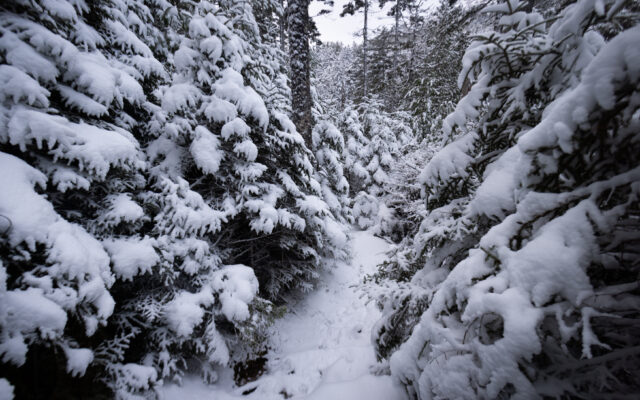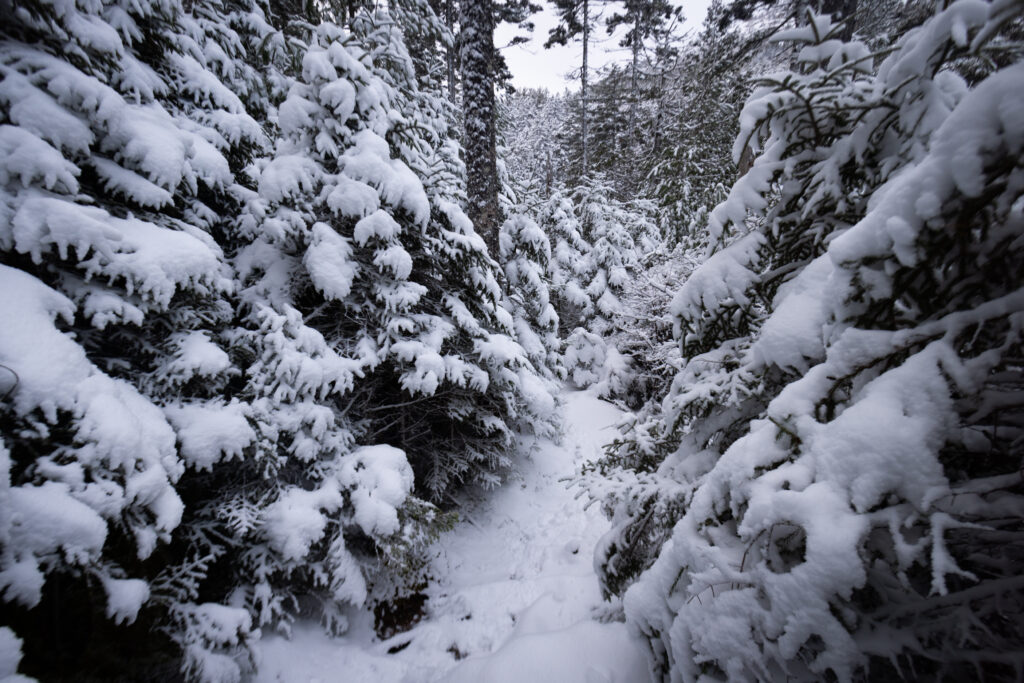
Magical ‘marshmallow trees’ will get you in the Christmas spirit
By Aislinn Sarnacki
The wilderness is beautiful in a special way after it snows, and I’m always eager to get out and see it. My favorite thing to do is visit an evergreen forest and go for a walk.
While all types of habitats are lovely when coated in fresh snow, I especially like the look and feel of an evergreen forest — one with pine, spruce, hemlock and fir trees. The trees’ needles hold onto the snow, transforming them into rounded, hulking shapes that, in my imagination, could be frost trolls or abominable snowmen.
For a while now, I’ve referred to snow-covered evergreens as “marshmallow trees.†A quick Google search has revealed to me that this is not necessarily a well-used term. But I did learn that sticking marshmallows on tree branches is a popular April Fools’ joke, presumably to confuse children.
Marshmallow trees are magical, and they’re also great shelter from the biting winter wind. Because of this, evergreen forests can be noticeably warmer — even cozy — during the cold months.

MARSHMELLO TREES — Snow weighs down the branches of evergreen trees on Dec. 4, at Donnell Pond Public Reserved Land in Hancock County.
And there’s something I find comforting about being surrounded by towering, snow-covered trees. Maybe that’s a side effect of playing in the woods as a child.
On a recent December morning, I woke up to several inches of fresh, fluffy snow and hurried through my computer work so I could find myself a forest to wander in that afternoon. When wracking my brain for where to go, a few particularly lovely spots came to mind.
The first was the Bangor City Forest. It’s a popular place, but it’s large enough with 680 acres that you can easily get a sense of solitude, especially if you wander far from the parking lots.
It features some truly massive white pine trees, plus stands of younger, shorter evergreens that will have you feeling like you’re strolling through a Christmas tree farm.
But I wanted to visit a place that would be a bit quieter, so I took a drive to Donnell Pond Public Reserved Land, which covers more than 14,000 acres of forestland, mountains and remote ponds in Hancock County.
My dog, Juno, had been whining to go outside all morning. And when we took a short walk down the road — necessary for her to take a morning poop — she laid down in the fresh snow and wouldn’t get up. She loves the snow, and is quite dramatic about it.
So you can imagine how thrilled she was when we went for an afternoon hike around the base of Tunk Mountain, which is one of the many hikes in Donnell Pond Public Reserved Land.
Following blue blazes, we walked a 1-mile loop trail to visit the shores of Salmon and Little Long ponds. We also shot off onto the Tunk Mountain Trail to visit Mud Pond.
The ponds were just starting to freeze over, a thin sheet of ice creeping out from the shore. Under an overcast sky, the open water was steely gray and reflected the trees along the banks.
Overall, our jaunt was about 2.5 miles, just long enough to stretch our legs and unwind.
Some other beautiful, evergreen-filled hiking locations that I’ve explored in the winter are Branch Lake Public Forest in Ellsworth, Little Moose Mountain near Greenville and Great Pond Mountain in Orland.
But, as a rule, evergreens aren’t hard to find in Maine.
We’re lucky in Maine to have a diversity of forest types and other habitats due to the state’s latitude and location on the coast. Many hiking trails start out in one type of forest and end up in another.
I especially notice this in the mountains, where a forest that’s predominantly hardwood — with beech, birch, maples and oaks — will abruptly change to spruce and pine stands at higher elevations.
But I even notice this on the road I live on. My house sits atop a hill, nestled in a stand of beech trees, interrupted by a few paper birches, red oaks and sugar maples.
But at the bottom of the hill, as I walk along the road, the forest suddenly changes to hemlocks.
This transition makes the walk more interesting, because I can find different types of understory plants, lichen and fungi among the different trees.
Along the coast, maritime spruce-fir forests, filled with moss and trailing lichen, are among the most enchanting habitats I’ve ever seen. Many of the preserves on Deer Isle feature these amazing forests, and I loved visiting them in the winter.
After a snowstorm, if you’re lucky, you’ll arrive at one of these trails before anyone else has a chance to mark the snow with their footprints. Such was the case for my recent trip to Donnell Pond Public Lands.
The Hidden Ponds Trail was free of footprints, unless you count squirrel tracks. The unmarred blanket of snow made the scene feel especially peaceful and remote.
In some areas, the forest was so dense that the snow-covered trees formed an impenetrable wall on both sides of the trail, a hallway in the woods. In other places, the understory opened up to reveal giant boulders and imposing pines.
I felt particularly lucky to be surrounded by a winter wonderland so early in the season. While I enjoy a good display of Christmas lights, there’s nothing quite like a snowy forest to get me in the holiday spirit.
If you go for a snowy walk yourself, I highly suggest bringing a thermos of peppermint hot chocolate along — and perhaps wearing a festive hat.
Make an event of it, even if it’s just you and the marshmallow trees.